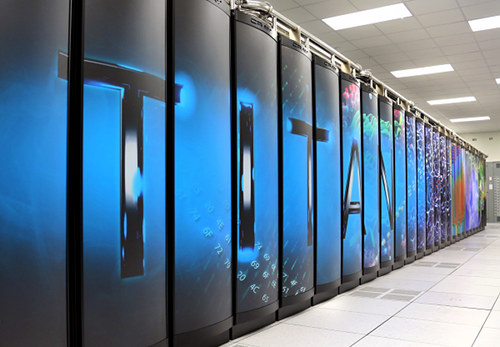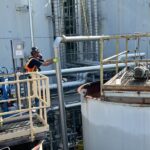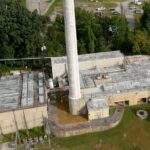
The Titan supercomputer at Oak Ridge National Laboratory was once ranked as the world’s most powerful supercomputer, but it is now ranked number four. (Photo courtesy of ORNL)
Note: This story was updated at 10:40 a.m.
Once the world’s most powerful supercomputer, Titan at Oak Ridge National Laboratory dropped to number four on a list of the world’s most powerful supercomputers released Monday.
Titan, a Cray XK7 system, was bumped from the number three spot by the upgraded Piz Daint, a Cray XC50 system installed at the Swiss National Supercomputing Centre.
China continues to have the world’s two most powerful supercomputers.
The TOP50 List of the world’s most powerful supercomputers is based on a benchmark test known as Linpack. The list is released twice each year, once in June and again in November. The 49th edition of the TOP500 List was released Monday in conjunction with the opening session of the ISC High Performance conference, which is taking place this week in Frankfurt, Germany.
In the latest rankings, the Sunway TaihuLight maintains its top position. TaihuLight is a system developed by China’s National Research Center of Parallel Computer Engineering and Technology, and it is installed at the National Supercomputing Center in Wuxi.
“With a Linpack performance of 93 petaflops, TaihuLight is far and away the most powerful number-cruncher on the planet,” a TOP500 press release said.
Tianhe-2 (Milky Way-2), a system developed by China’s National University of Defense Technology and deployed at the National Supercomputer Center in Guangzho, China, occupies the number two position with a Linpack mark of 33.9 petaflops. Tianhe-2 was the number one system in the TOP500 list for three consecutive years, until TaihuLight eclipsed it in June 2016.
The upgrade of Piz Daint, the Swiss computer that is now number three, was accomplished with additional NVIDIA Tesla P100 GPUs. That doubled the Linpack performance of the system’s previous mark of 9.8 petaflops in November 2016, which itself was the result of a significant upgrade, the press release said. Piz Daint’s current Linpack result of 19.6 petaflops enabled the system to climb five positions in the rankings.
Titan’s Linpack mark of 17.6 petaflops has remained constant since it was installed in 2012, the press release said. A petaflop is one quadrillion calculations per second. That’s 1,000 trillion calculations per second.
Titan was the top supercomputer for a short time. It was number one in November 2012, but it was bumped to number two behind Tianhe-2 in June 2013. June 2016 was the first time it had been number three. It continued to be ranked number three in November 2016. Piz Daint bumped it to number four on Monday.
As big as a basketball court, Titan is 10 times faster than Jaguar, the computer system it replaced. Jaguar, which was capable of about 2.5 petaflops, had ranked as the world’s fastest computer in November 2009 and June 2010.
Titan is used for research in areas such as materials research, nuclear energy, combustion, and climate science.
With the two Chinese supercomputers and one Swiss system occupying the top of the rankings, this is the second time in the 24-year history of the TOP500 list that the United States has failed to secure any of the top three positions, the press release said. The only other time this occurred was in November 1996, when three Japanese systems captured the top three spots.
In June 2016, ORNL officials said a new 200-petaflop supercomputer will succeed Titan, and it could be available to scientists and researchers in 2018. The new IBM supercomputer, named Summit, could about double the computing power of Sunway TaihuLight.
Summit is one of three supercomputers that the U.S. Department of Energy has said it expects to exceed 100 petaflops at three DOE laboratories in 2018.
Rounding out the top 10 in the list released Monday are:
- Sequoia (17.2 petaflops), an IBM BlueGene/Q system installed at the DOE’s Lawrence Livermore National Laboratory, at number five;
- Cori (14.0 petaflops), a Cray XC40 system housed at the National Energy Research Scientific Computing Center, at number six;
- Oakforest-PACS (13.6 petaflops), a Fujitsu PRIMERGY system running at Japan’s Joint Center for Advanced High Performance Computing, at number seven;
- Fujitsu’s K computer (10.5 petaflops), installed at the RIKEN Advanced Institute for Computational Science (AICS), at number eight;
- Mira (8,6 petaflops), an IBM BlueGene/Q system installed at DOE’s Argonne National Laboratory, at number nine; and
- Trinity (8.1 petaflops), a Cray XC40 system running at Los Alamos National Laboratory, at number 10.
Despite not having any of the top three spots, the United States still claims five of the top 10 supercomputers, which is more than any other nation. It also leads the pack in the total number of TOP500 systems, with 169. China is a close second with 160. However, both countries lost share compared to six months ago, when they each claimed 171 systems. Besides the U.S. and China, the most well-represented countries on the list are Japan, with 33 supercomputers; Germany, with 28; France, with 17, and the UK, with 17.
Aggregate performance on the TOP500 rose to 749 petaflops, a 32 percent jump from a year ago. Such an increase, though, is well below the list’s historical growth rate of approximately 185 percent per year. The slower growth in list performance is a trend that began in 2013, and has shown no signs of reversal.
Intel continues to be the dominant supplier of TOP500 chips. Either Xeon or Xeon Phi processors power 464 of the 500 systems. IBM Power processors are in 21 systems, while AMD Opteron CPUs are present in six systems. Processor share, with regard to supplier, has not changed appreciably over the last year.
In the system vendor arena, Hewlett Packard Enterprise claims the most TOP500 systems, with 144. These include 25 systems originally installed by SGI, which HPE purchased in 2016. Lenovo is the second most popular vendor, with 88 systems, and Cray is in third place, with 57.
Cray systems, however, continue to lead in overall performance, claiming 21.4 percent of the list’s total performance. HPE is well back in second place, with an overall performance share of 16.7 percent. Thanks to its number one Sunway TaihuLight system, NRCPC retains the third spot with 12.5 percent of the total performance.
Energy efficiency on the list continues to rise, as reflected in the latest Green500 results. The top four positions are all occupied by newly installed systems in Japan, with the upgraded Piz Daint supercomputer capturing the number five spot. All of these use NVIDIA’s latest P100 GPUs. In fact, the top 13 systems on the latest Green500 are all equipped with the P100 hardware.
The most energy-efficient system on the Green500 list is the new TSUBAME 3.0, a modified HPE ICE XA system installed at the Tokyo Institute of Technology. It achieved 14.110 gigaflops/watt during its 1.998-petaflop Linpack performance run. It is ranked number 61 on the TOP500 list.
Please see the TOP500 website for the full press release.
About the TOP500 List
The first version of what became today’s TOP500 list started as an exercise for a small conference in Germany in June 1993. Out of curiosity, the authors decided to revisit the list in November 1993 to see how things had changed. About that time they realized they might be onto something and decided to continue compiling the list, which is now a much-anticipated, much-watched, and much-debated twice-yearly event.
The TOP500 list is compiled by Erich Strohmaier and Horst Simon of Lawrence Berkeley National Laboratory; Jack Dongarra of the University of Tennessee in Knoxville; and Martin Meuer of ISC Group, Germany.
More information will be added as it becomes available.
Do you appreciate this story or our work in general? If so, please consider a monthly subscription to Oak Ridge Today. See our Subscribe page here. Thank you for reading Oak Ridge Today.
Copyright 2017 Oak Ridge Today. All rights reserved. This material may not be published, broadcast, rewritten, or redistributed.





Leave a Reply